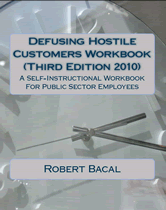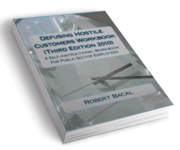Customer Reviews of The Defusing Hostile Customers Workbook For Government

Your can order the book directly from amazon to take advantage of their return guarantee, and fast shipping. Click the cover.
Here are a few customer reviews of our book, mostly written and posted to amazon.com.
Consultate: Received Via Email in Sept. 2013
The following was an unsolicited review from a consulate located in the Unitied States. We've removed the identifying information to preserve confidentiality
Dear Mr. Bacal,
The book that you have written entitled " Defusing Hostile Customers Workbook" has helped our employees at the (Country name) Consulate General -San Francisco in dealing with different clients. You have shared a lot of insights which are beneficial in improving our Customer Service. We were able to learn how to effectively communicate with hostile clients. As you have mentioned in your book, it is not really easy to deal with a public that still does not easily trust those who work in government.
However, I believe that we can always learn and improve ourselves on how to become more efficient. And one of the ways of achieving this is through continuous education and training for our employees. Thank you very much for writing and sharing your knowledge through your book. Truly amazing!
Sincerely, -- (Name Removed) Customer Service Trainer (Country Consulate General in San Francisco
From Stephen Katz, who works in the Minnesota State Government:
The Defusing Hostile Customers Workbook (Third Edition 2010) by Robert Bacal is the best material I've ever seen on this subject. It gives the government worker everything he or she needs to defuse hostile customers. I can unequivocally recommend this book for any government worker who regularly deals with hostile customers.
The business case for buying this book is that angry customers eat up lots of organizational time and energy, particularly when they decide to climb the organizational ladder with their complaints.
The promise Bacal makes for the Defusing Hostile Customers Workbook is that: "Employees can do things to defuse anger and reduce abusive behavior. People can learn to act in ways that reduce this kind of behavior, and ensure that they do not do anything that will result in an unpleasant situation going ballistic." Escalation doesn't have to happen. This workbook fulfills that promise magnificently well.
The Defusing Hostile Customers Workbook is a workbook, a manual, and a practice guide all in one. Bacal's content is enriched from the experience of several thousand public sector employees who have participated in Bacal's seminar called Defusing Hostile Customers.
The workbook features 117 tactics you can use effectively to defuse hostile customers, and it has useful, thought provoking exercises you can do. The tactics will reduce your stress levels at work and protect your valuable time.
This workbook doesn't use a cookie cutter approach. As Bacal says, "There are no hard rules that you apply automatically to defuse angry customers. Each hostile situation is different. There is no magic solution or cookbook approach that works every time." But, his solutions are exceptionally useful and hands on.
The core concepts of the workbook center around a master strategy called the CARP System. The letters in CARP stand for Control, Acknowledge, Refocus, and Problem solve. You can't problem-solve until you've done the first three steps, and it's crucial to deal with the feelings first.
Among the many pivotal tactics and concepts that the workbook offers are the following: The language you use. Type 1 language is confrontational even if you might not think it so. Type 2 language is the language you should use, cooperative language. Bacal also gives us eight verbal self-defense techniques. And, sometimes you have to refer a hostile customer to another worker, supervisor, or manager, so Bacal offers a chapter on referral techniques that use third parties to defuse hostile situations.
Reading the Assertive Limit Setting chapter alone is worth the price of the Workbook. The workbook emphasizes that it's crucial when dealing with unacceptable behavior to use assertive limit setting by describing the unacceptable behavior, requesting behavior change, and stating consequences. Here is one of Bacal's examples: "Sir, if you continue to swear and yell, I will have to end our conversation. Would you prefer to continue or stop now?"
The 2010 edition of the Defusing Hostile Customer's Workbook has two new sections. The first new section is Customer Interactions through Media. Bacal delivers a profound message when he tells us that when the medium changes, so does the communication. He then describes those changes in clear language. Bacal teaches us that customer service, marketing and branding, and reputation management have converged into one entity. Therefore, "anything that negatively affects people's perceptions of government affects you." So when customers enter communication with government employees, those customers often have a chip on their shoulders. That makes it much more difficult to defuse the customers' anger, since their anger is based on expectations and prejudice and not on direct experience with the government employee.
The section on email exposes the limits of email and shows how best to use it to convey facts, but we should all be warned that email as a communication mode has many problems. Bacal cites a 2004 study of internet service providers that suggested that as much as 25 percent of requested corporate email was inaccurately identified as junk email and sent to the junk folder or deleted. The workbook also gives insights into social media and its limits for our work.
The other new chapter is about Audiences, Groups, Crowds, and Mobs.
The material on delivering presentations to hostile or resistant audiences and public speaking will be particularly relevant to anyone who presents government positions and policies to hostile or angry audiences. Those audiences are often not happy to hear the information we deliver. Bacal gives us the means to enhance our credibility by focusing on the similarities we share with the audience such as how we dress, common ground we share, the language we use, etc. He stresses preparation, focusing on your audience's concerns, using a balanced approach that honestly broaches the audience's objections that we've anticipated. Finally, he stresses the value of co-presenting or using a team speaking approach to cover for each other and to play off each other's strengths.
Buy this book!
Submitted by Steve Katz, Trainer, Child Support Enforcement Division, Minnesota Department of Human Services.
From T. Tyler in Canada:
We use this book in our organization to help staff, keep a copy in each field office because we work in an industry where customers can get upset. Obviously we like it. The content goes beyond the usual "smile" training, and staff particularly like learning how to get ranting customers to be quiet and listen.
Once every few months we'll review a technique from it at a staff meeting, gets people talking.
The exercises and case studies are good, and they can be customized.
One thing I found is that I find myself using some of the techniques with my kids.
Downside. The writing isn't all that exciting, but it is clear if somewhat repetitive.
From Autumn Bell on an earlier edition:
Robert Bacal has filled a niche that has been empty for too long - customer service literature that focuses on the public sector. Most customer service material is geared toward the private sector - retail, manufacturing, etc. Advice on such topics as winning customer loyalty, pricing, word-of-mouth advertising, etc. doesn't always apply to the world of the government agency, the university, or the Motor Vehicles Department. In many public sector jobs, telling people "no" and telling them what they "must" do is a regular part of the job - and this leads to a natural increase in hostility from patrons. I have researched countless customer service books, programs and resources to use here at our public institution. Not only is Robert Bacal's material one of the only sources geared specifically to the public sector, it is also one of the best sources on handling upset, angry, or hostile customers that I've ever seen - for any type of workplace! Beginning with a four-part model (or process) for defusing hostile customers, he then goes into countless specific tips and techniques that are as practical as they are effective. He goes so far beyond the trite techniques found in other customer service materials to cover topics such as: · how to tell someone "no" in a way that doesn't elicit hostility · handling non-verbal intimidation · verbal self-defense · a step-by-step process for "solving" customer problems · dealing with threats · and much more! Examples of dialogue and written exercises in each section help readers apply the material. We have tried these techniques here at work and the results have been outstanding. I highly recommend this book for anyone who encounters customers, clients, patients, students, or members of the public - whether you work in the public or the private sector. This is the best source on handling customers you can find!
And From B. Schlitz on an earlier edition:
I just wanted to tell everyone that I am very satisfied with this book and the delivery of it was ahead of schedule. There is a ton of very informative and useful information in this book. A MUST READ! for anyone who is a government employee or call centre rep who deal with people on a daily basis. I am about to work for a call centre and I find this book easy to understand and easy to learn. I am one very satisfied customer indeed. thank you.
